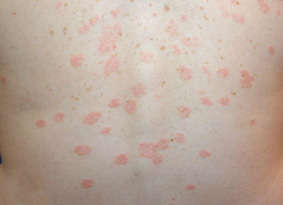Pityriasis Rosea & it’s Homeopathic Treatment
Pityriasis rosea, possibly a viral infection, is a common skin disease that presents itself as scaly, reddish-pink rash. This condition is mostly seen in children and young adults.
Causes:
- The cause remains unknown.
- It is noncontagious.
- Some of the studies suggest that it may be caused by viruses or after taking certain medications such as antibiotics or cardiac medications.
- This condition is triggered or aggravated in winter.
- It is most commonly seen in the age group of 10-35 years

Symptoms:
- The rash usually appears on the back, abdomen, or chest and then spreads to the neck, arms, and legs.
- The rash may remain for some days to several weeks. It may be self-limiting in many cases and may resolve in about 2-3 months without medicines.
- General feeling of getting ill as tired and achy or getting cold just before the rash appears.
- The rash may be seen as what may be called a ‘herald patch’ which is the first sign to appear.
- The rash appears as a large, oval, scaly lesion typically seen on the back, abdomen, armpit, or chest.
- In a few days time the rash may spread to other parts of the body presenting as skin redness or inflammation.
- Rash found on the back tend to form a Christmas tree pattern.
- Typically the rash exists without itching, however, in some patients, mild itching may be present.
- Exposure to heat or cold, vigorous exercise, etc can worsen itching.
- It may lead to skin discoloration after the rash is subsided which usually takes months to fade.
Diagnosis:
- Mostly diagnosed clinically by expert eyes.
- Since this condition can look like other skin disorders like eczema, ringworm, syphilis, or psoriasis, a skin biopsy may be required to confirm the diagnosis.

Treatment:
The rash usually goes away on its own in around 2-3 months time but sometimes the symptoms are so distressing that it need to be treated. In some cases, it may remain for more than 3 months.
- Conventional medicines aim at relieving itching and inflammation caused by pityriasis rosea. The medicines include antihistamines, local and oral corticosteroids, and calamine lotion.
Homeopathic management:
Homeopathic treatment is found effective in Pityriasis rosea and it is strongly recommended, especially in resistant and severe cases.
Here's a list of some commonly used homeopathic medicines for Pityriasis rosea:
1) Sulphur: Sulphur is indicated when one experiences intense itching which is worse by warmth causing frequent scratching. The skin appears dry and scaly and has a rough texture. The rash becomes redder after scratching or after exposure to heat. It is suitable for individuals who suffer from recurrent episodes of skin issues. The complaints of skin are worse with sweating; any activity that leads to sweating such as exercise or being in a humid environment increases the itching and rash. The rash may resemble eczema and over time the affected areas can develop thickened rough patches due to chronic irritation and scratching.
2) Graphites: Graphites have typical skin eruptions wherein the rash may ooze a sticky, honey-like fluid after scratching or irritation. The affected areas are dry and cracked making the skin feel tight and uncomfortable. Over time the skin gets thickened particularly the areas prone to friction such as folds or creases due to chronic inflammation. The rash may heal slowly with persistent irritation, cracks, and recurring eruptions. After recovery, the skin may remain discoloured with either darker patches or lighter in colour indicating deep skin involvement.
3) Arsenicum Album: Arsenicum album is accompanied by a strong burning sensation that worsens at night with exposure to cold air. The individual feels highly restless and anxious due to the discomfort caused by the rash, often making one keep moving to find relief. The rashes are dry with fine scales that flake off causing the skin to feel tight and rough to touch. The individual may experience significant anxiety about their health fearing that the rash is more serious and will cause harm to the body. The skin eruptions are better by warm, applying warmth to the skin can temporarily soothe the burning and itching providing relief from the irritation. The rash may leave behind pale and discoloured spots once it heals, particularly in areas that are intensely irritated.
4) Kali Sulphuricum: Kali sulph presents with yellowish scales or flakes a distinct feature for the use of this remedy. After the initial rash, the skin may peel, leaving behind areas of dry, flaky patches. The patches appear on the body that are often warm such as the chest, and back. The rash is migrating in nature; the rash shifts locations moving from one part of the body to another indicating a tendency for the symptoms to wander. The condition may improve for a time, only to flare up again, especially during the changes in weather or due to heat. The skin appears thin and delicate, with fine scaling that can become more pronounced in areas affected by the rash.
5) Sepia: Sepia is indicated for pityriasis rosea when rashes are ring-shaped or circular with dry, scaly patches, especially on the trunk and limbs. The rash is associated with intense burning and itching which is worse after scratching. The flare-ups usually happen due to hormonal changes such as menstruation, menopause, or during pregnancy, so the condition may go through a period of remission and recurrence with skin eruptions returning during periods of stress and hormonal changes.
Related condition: Tinea alba, Tinea Corporis, Tinea Versicolor
Written & Approved by-
Dr. Rajesh Shah
M.D. (Hom.)